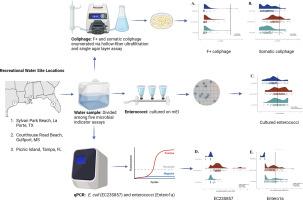墨西哥湾休闲水域粪便指示微生物的培养和分子测定
IF 8
1区 环境科学与生态学
Q1 ENVIRONMENTAL SCIENCES
引用次数: 0
摘要
娱乐用水通常是通过枚举粪便指示细菌(如肠球菌)来评估的,但研究表明,病毒指示细菌可能更适合娱乐用水的水质应用。体细胞和F+噬菌体被认为是娱乐水域中病毒性病原体的预测因子,但同时测量肠球菌和噬菌体以及比较不同基于风险的海滩作用值(bav)是有限的。我们收集了来自墨西哥湾三个海滩的肠球菌、大肠杆菌、体细胞和F+噬菌体的成对测量。在mEI琼脂和qPCR (Entero1a:靶序列[TS])上枚举肠球菌(集落形成单位:CFU)。大肠杆菌采用qPCR (EC23S587, TS)进行计数。采用无端中空纤维超滤和单琼脂层法对噬菌体(斑块形成单位:PFU)进行计数。Entero1a与培养的肠球菌相关性最大(r≥0.51,p≤0.0001),F+噬菌体与培养的肠球菌相关性最小(r≤0.01,p = 1.0)。对可培养肠球菌(60 CFU/100 mL)、Entero1a (9658 TS /100 mL)和建议的体细胞(14 PFU/100 mL)和F+ (3 PFU/100 mL)阈值应用等效的bav,结果表明,总体而言,噬菌体和Entero1a在海滩咨询状态方面的一致性最大(74 - 82%),而培养肠球菌和体细胞噬菌体之间的一致性最低(65%)。这一丰富的数据集不仅为墨西哥湾的噬菌体和FIB的发病率提供了有价值的见解,而且为未来研究亚热带海水的粪便来源识别和水质预测模型提供了基础。本文章由计算机程序翻译,如有差异,请以英文原文为准。

Cultured and molecular measures of fecal indicator microbes in Gulf of Mexico recreational waters
Recreational waters are routinely assessed by enumeration of fecal indicator bacteria, such as enterococci, but research suggests viral indicators may be better suited for recreational water quality applications. Somatic and F+ coliphage were proposed as predictors of viral pathogens in recreational waters, but concurrent measurements of enterococci and coliphages and comparisons across different risk-based beach action values (BAVs) are limited. We collected paired measurements of enterococci, E. coli, somatic and F+ coliphage from three Gulf of Mexico beaches. Enterococci (colony forming units: CFU) were enumerated on mEI agar and by qPCR (Entero1a: target sequence [TS]). E. coli was enumerated by qPCR (EC23S587, TS). Coliphages (plaque forming units: PFU) were enumerated using dead-end hollowfiber ultrafiltration and single agar layer assay. The largest correlation observed was between Entero1a and cultured enterococci (r ≥ 0.51, p ≤ 0.0001) and the smallest (r ≤ 0.01, p = 1.0) between F+ coliphage and cultured enterococci. Applying equivalent BAVs for culturable enterococci (60 CFU/100 mL), Entero1a (9658 TS per 100 mL) and suggested somatic (14 PFU/100 mL) and F+ (3 PFU/100 mL) thresholds resulted in the overall greatest agreement in beach advisory status between coliphages and Entero1a (74–82 %) and lowest between cultured enterococci and somatic coliphage (65 %). This rich data set not only provides valuable insights on the incidence of coliphage and FIB in the Gulf of Mexico but will also provide a foundation for future research on fecal source identification and water quality forecast modeling in sub-tropical marine waters.
求助全文
通过发布文献求助,成功后即可免费获取论文全文。
去求助
来源期刊

Science of the Total Environment
环境科学-环境科学
CiteScore
17.60
自引率
10.20%
发文量
8726
审稿时长
2.4 months
期刊介绍:
The Science of the Total Environment is an international journal dedicated to scientific research on the environment and its interaction with humanity. It covers a wide range of disciplines and seeks to publish innovative, hypothesis-driven, and impactful research that explores the entire environment, including the atmosphere, lithosphere, hydrosphere, biosphere, and anthroposphere.
The journal's updated Aims & Scope emphasizes the importance of interdisciplinary environmental research with broad impact. Priority is given to studies that advance fundamental understanding and explore the interconnectedness of multiple environmental spheres. Field studies are preferred, while laboratory experiments must demonstrate significant methodological advancements or mechanistic insights with direct relevance to the environment.
 求助内容:
求助内容: 应助结果提醒方式:
应助结果提醒方式:


